Journal of Hazardous Materials ( IF 13.6 ) Pub Date : 2021-10-16 , DOI: 10.1016/j.jhazmat.2021.127447 Marcel Schneider 1 , Marina F Grossi 2 , Darshak Gadara 2 , Zdeněk Spáčil 2 , Pavel Babica 2 , Luděk Bláha 2

|
Drinking water treatment ultimately aims to provide safe and harmless drinking water. Therefore, the suitability of a treatment process should not only be assessed based on reducing the concentration os a pollutant concentration but, more importantly, on reducing its toxicity. Hence, the main objective of this study was to answer whether the degradation of a highly toxic compound of global concern for drinking water equals its detoxification. We, therefore, investigated the treatment of cylindrospermopsin (CYN) by •OH and SO4-• produced in Fenton and Fenton-like reactions. Although SO4-• radicals removed the toxin more effectively, both radical species substantially degraded CYN. The underlying degradation mechanisms were similar for both radical species and involved hydroxylation, dehydrogenation, decarboxylation, sulfate group removal, ring cleavage, and further fragmentation. The hydroxymethyl uracil and tricyclic guanidine moieties were the primary targets. Furthermore, the residual toxicity, assessed by a 3-dimensional human in vitro liver model, was substantially reduced during the treatment by both radical species. Although the results indicated that some of the formed degradation products might still be toxic, the overall reduction of the toxicity together with the proposed degradation pathways allowed us to conclude: “Yes, degradation of CYN equals its detoxification!”.
中文翻译:

用羟基和硫酸根处理柱孢菌素:降解等于解毒吗?
饮用水处理最终旨在提供安全无害的饮用水。因此,处理过程的适用性不仅应基于降低污染物浓度的浓度来评估,更重要的是应基于降低其毒性来评估。因此,本研究的主要目的是回答全球关注的饮用水的剧毒化合物的降解是否等于其解毒。因此,我们研究了在 Fenton 和 Fenton 样反应中产生的 •OH 和 SO 4 - •对圆柱体藻红 (CYN) 的处理。虽然 SO 4 -• 自由基更有效地去除了毒素,两种自由基物质都显着降解了CYN。两种自由基物质的潜在降解机制相似,涉及羟基化、脱氢、脱羧、硫酸基团去除、环裂解和进一步碎裂。羟甲基尿嘧啶和三环胍部分是主要目标。此外,通过 3 维人体外肝脏模型评估的残留毒性在两种自由基物种的治疗过程中显着降低。虽然结果表明一些形成的降解产物可能仍然有毒,但毒性的总体降低以及所提出的降解途径使我们得出结论:“是的,CYN 的降解等于其解毒!”。



























 京公网安备 11010802027423号
京公网安备 11010802027423号